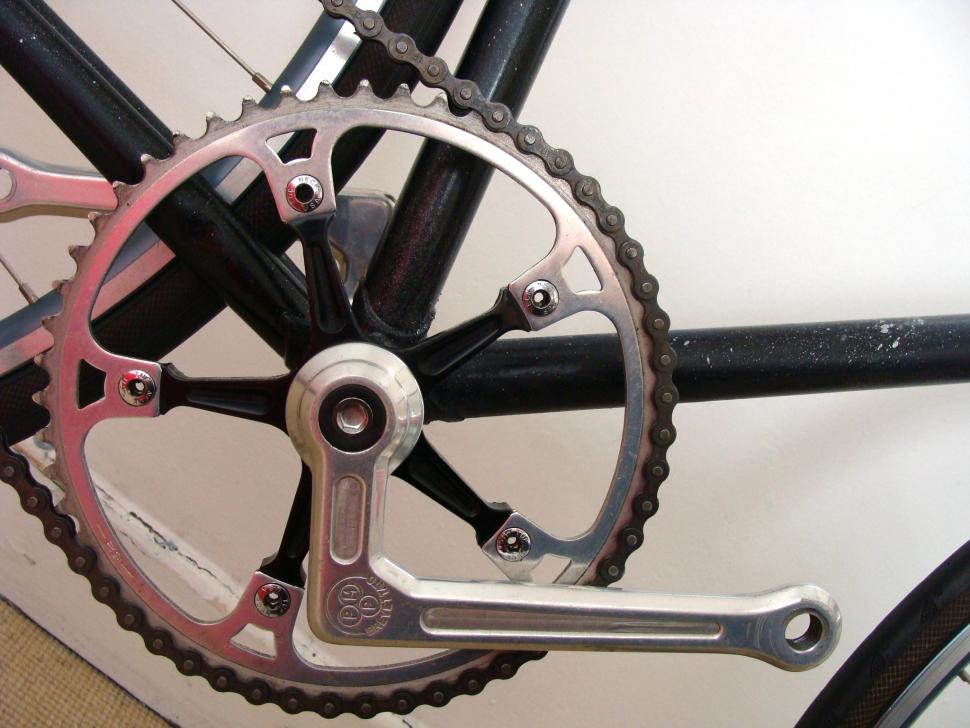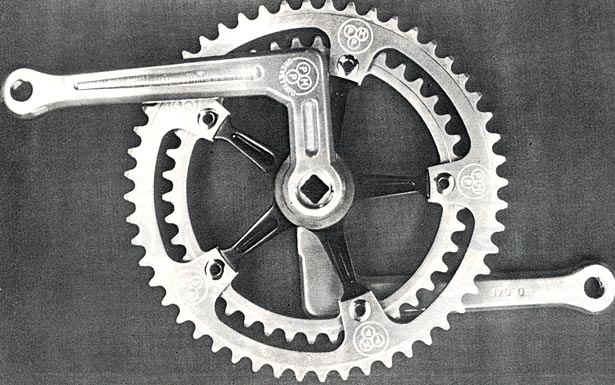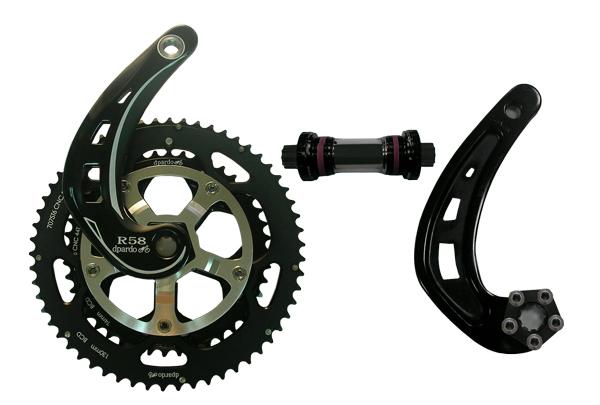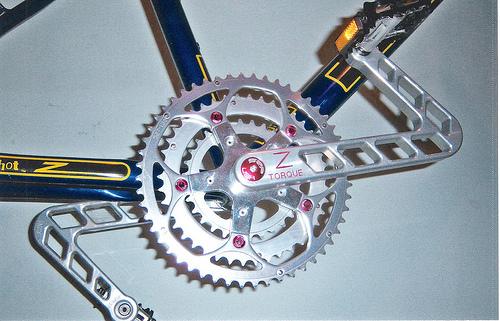- News
- Reviews
- Bikes
- Accessories
- Accessories - misc
- Computer mounts
- Bags
- Bar ends
- Bike bags & cases
- Bottle cages
- Bottles
- Cameras
- Car racks
- Child seats
- Computers
- Glasses
- GPS units
- Helmets
- Lights - front
- Lights - rear
- Lights - sets
- Locks
- Mirrors
- Mudguards
- Racks
- Pumps & CO2 inflators
- Puncture kits
- Reflectives
- Smart watches
- Stands and racks
- Trailers
- Clothing
- Components
- Bar tape & grips
- Bottom brackets
- Brake & gear cables
- Brake & STI levers
- Brake pads & spares
- Brakes
- Cassettes & freewheels
- Chains
- Chainsets & chainrings
- Derailleurs - front
- Derailleurs - rear
- Forks
- Gear levers & shifters
- Groupsets
- Handlebars & extensions
- Headsets
- Hubs
- Inner tubes
- Pedals
- Quick releases & skewers
- Saddles
- Seatposts
- Stems
- Wheels
- Tyres
- Health, fitness and nutrition
- Tools and workshop
- Miscellaneous
- Tubeless valves
- Buyers Guides
- Features
- Forum
- Recommends
- Podcast
 PMP cranks 2.jpg
PMP cranks 2.jpgL-shaped cranks — explore the crazy idea that just won't die
Image: PMP cranks by robadod from LFGSS [This feature from the road.cc archive was last republished on October 15, 2020]
We take a look at one of the more bizarre technical aberrations of recent history: the wackiest cranks ever made.
In 1981 Cycling Weekly magazine published a favourable review of an unusual new crank. The magazine gave a set to “a first-category Surrey roadman to try them out.”
The write-up said: “He fitted them in March and although our test is now over they are still on his best road bike. He has come to prefer them to orthodox cranks.”
CW’s tester “enjoyed the ‘feel’ of the cranks and reported that the slower his pedalling speed the more advantage he felt, which is perhaps why they are finding favour with big-geared time triallists.”
The tester told CW: “I didn't just get the power on the downward strokes of the pedals but all the way round the pedalling revolution as at low pedalling speeds dead centre seemed to be removed. This helped me keep a steady rhythm particularly when sitting back in the saddle climbing hills.”
He didn’t feel the same benefit when pedalling quickly in a low gear, though.
CW concluded: “So there is the verdict, whatever the theories, in practice our roadman tester felt the PMP cranks offered an advantage – and surely that is the true criterion.”
That crank was the PMP Brevettato. Its unusual (but, as we’ll see, by no means unique) feature was a right angle bend about a third of the way between the bottom bracket axle and the pedal.
PMP made some interesting claims about the Brevettato cranks. They included:
- The unique form of the PMP pedal crank means improved distribution of the energy required in pedalling and a perfectly round stroke; the result: increased equilibrium.
- Its L-shaped design increases the pedal's propulsion power and lessens energy dispersion on the downstroke.
- Pedalling the PMP way means to be perfectly in the saddle; in fact, the bicycle rider is forced to lean back slightly more than usual, putting him in the best possible aerodynamic position.
- The PMP pedal crank means that pedalling is no longer an "ankle game" since the bottom dead-point is lightened to allow greater ease on the upstroke.
- Bicycling becomes a pleasure and not a chore because the PMP pedal crank and its unique features take away the exertion and lighten muscle strain.
Bold claims, and with Cycling Weekly’s Surrey roadman finding they eliminated dead centre, you have to wonder why the design isn’t now ubiquitous.
That’s simple: it’s all bollocks.
A crank is a lever. The torque you generate when you load up the end of a lever depends on just two things: the force you exert and the distance between the point where that force is applied and the pivot.
Nothing else matters, especially not the route the lever takes between the two points. It can be a straight line, a right angle bend or any other shape; it doesn’t matter. All you achieve by making a crank any other shape than straight is to add weight and flexibility.
PMP cranks were even marked with the distance between the crank and pedal holes. As the Bicycle Museum of Bad Ideas remarks: “somebody at PMP understood it was simply an odd way to make a 175mm crank”.
Pretty much everyone who was paying attention in physics at school pointed this out at the time, but that didn’t stop a fad for PMP Brevettatos, especially among time triallists.
Even the great 80s time triallist Ian Cammish used them. Cammish, who won the Best British All-Rounder contest nine times in the 1980s, mentioned them when he tried to sell one of his 1983 bikes on eBay in 2013.
“Unfortunately the PMP cranks cracked a long time ago,” he wrote.
They had a bit of a reputation for that, though to be fair so did many other high-end cranks of the era.
Perhaps because of these reliability issues, and because not many were made in the first place, PMP Brevettato cranks are now rare and collectible. The most recent set I’ve seen on eBay went for US$400 — almost £300.
Other wonky cranks
The bike industry has a serious problem with knowledge loss, which leads to people who really should know better reinventing bad ideas over and over. The PMPs weren’t the first non-straight cranks (the earliest seem to have been in 1897), nor the last. Like the monster lurching back to life at the end of a bad horror movie, wonky cranks keep coming back.
Want to make people go “What the hell?” get yourself a set of dpardo Sickle Cranks:
It’s not at all clear what advantages dpardo claimed for this design. PMP had a slight case of ‘Campagnolo spoken here’ Italglish, but dpardo really needed to get a native speaker of English to write its marketing copy. It says — and I swear I haven’t changed a letter of this:
58T gear turns once is 1.6M faster than 50T!As same as pedaling 50T !Same pedaling force pedal 58T, the riding performance is 16% increasing than 50T with normal cranks
The craziest recent reappearance of wonky cranks has to be Z-Torque cranks, which came and went between 2010 and 2014.
The shape was claimed to have come to inventor Glenn Coment in a dream. He bent a wire coat hanger into the same shape and “when he revolved it in his hands he found that this crank assembly was different from any other crank assembly ever made. Except for top dead center and bottom dead center, this crank had no dead spots. He was amazed. And in future testing would find that during a rider's maximum effort, power increases at a bikes rear wheel of 20-25% were possible.”
If true, that would be little short of astounding.
Z Torque further claimed “many advantages, including”:
- Smoother pedaling
- More power to climb hills
- Less perceived effort to pedal
- Faster acceleration
- Less affected by headwinds
- Ability to turn higher gearing
However, the Z Torque was really just another crank that connected the bottom bracket axle and pedal by a circuitous route, with an extra problem baked in.
As you can see, the long arm of the V shape, is really, really long. Imagine trying to pedal while banked over hard in a corner and you can probably explain why Z-Torque cranks were never even as popular as PMP Brevettatos.
John has been writing about bikes and cycling for over 30 years since discovering that people were mug enough to pay him for it rather than expecting him to do an honest day's work.
He was heavily involved in the mountain bike boom of the late 1980s as a racer, team manager and race promoter, and that led to writing for Mountain Biking UK magazine shortly after its inception. He got the gig by phoning up the editor and telling him the magazine was rubbish and he could do better. Rather than telling him to get lost, MBUK editor Tym Manley called John’s bluff and the rest is history.
Since then he has worked on MTB Pro magazine and was editor of Maximum Mountain Bike and Australian Mountain Bike magazines, before switching to the web in 2000 to work for CyclingNews.com. Along with road.cc founder Tony Farrelly, John was on the launch team for BikeRadar.com and subsequently became editor in chief of Future Publishing’s group of cycling magazines and websites, including Cycling Plus, MBUK, What Mountain Bike and Procycling.
John has also written for Cyclist magazine, edited the BikeMagic website and was founding editor of TotalWomensCycling.com before handing over to someone far more representative of the site's main audience.
He joined road.cc in 2013. He lives in Cambridge where the lack of hills is more than made up for by the headwinds.
Latest Comments
- mdavidford 2 sec ago
No they didn't - not unless they provided hard, indisputable evidence that it wasn't the case. They may have rebuffed, rejected, or rebutted it,...
- wtjs 32 min 9 sec ago
they always strike me as being overpriced for the hardware...
- hawkinspeter 1 hour 7 min ago
What's that? A mobile home for squirrels?
- mark1a 1 hour 29 min ago
Brompton however....
- Backladder 1 hour 40 min ago
While original sash windows are nice they make it very hard to keep the house warm, we eventually went for upvc double glazed sash window...
- Andrewbanshee 3 hours 3 min ago
As you said the pedals will be hidden anyway. My shoes, 3 pairs of them, have reflective strips on the heel and my winter trousers do too on the...
- Steve K 3 hours 4 min ago
Other drivers only care about disabled people when it gives them a way to object to cycling infrastructure.
- mark1a 11 hours 7 min ago
I'll put you down as a no then.
- chrisonabike 16 hours 34 min ago
Well if you *can* interview the original riders at all surely they worked, at least?...




Add new comment
109 comments
In practise crank length doesn't seem to make much difference . People who experiment with widely varying crank lengths are able to adapt within a wide range without power output being materially affected.
As for leverage, that leverage is modified by the rear sprocket size, the front chainwheel size and the wheel size. What you're left with is your power output available to propel you uphill and if that doesn't vary much with crank length then neither does your uphill speed.
Kind of counter-intuitive all that but it does seem to be true.
Basically, yes a longer crank provides more torque. If you change your crank length, it's like changing your gearing.
Usually, people only change their crank lengths to improve their bike fit, so someone with long legs might want longer cranks and similarly, shorter legged riders might benefit from shorter cranks. It's quite useful on a tandem to have different crank lengths to allow different sized riders to use the same gear and cadence.
While that's true, I think it is imperceptible. Moving from a 172.5 to a 175 will give you, what, just over 1% difference in gearing? That's not even as big a difference as moving from a 53 to a 52 tooth chainring.
Complete rubbish. Changing the length of your crank DOES NOT change your gearing. The ONLY thing which changes the gearing for a given wheel is the ratio of the chainring to the sprocket, if your chainring is 4 times the size of your sprocket, for one revolution of your chainring your sprocket will go round 4 times regardless of the length of the lever (crank) turning it.
You're technically correct (the best kind of correct), but I'd like to point out that I was referring to the effective gearing which is the relationship between the force applied at the pedal and the force at the rear wheel. This can be changed by keeping all your gears the same, but changing the size of your back wheel or changing the length of your crank (although as srchar has pointed out a small size change doesn't make much difference).
Although the ratio of revolutions of chainring/sprocket is unchanged, the distance that your foot travels will increase per revolution with a longer crank and thus the work (Nm) increases. So, a much longer crank will make it feel like an easier gear.
Here's some info from the late Sheldon Brown on the subject: http://www.sheldonbrown.com/gain.html
Give me non round wheels....
https://www.youtube.com/watch?v=vk7s4PfvCZg
triangle-bicycle.jpg
Same with discs. They have advantages, they have disadvantages; why does somebody care what someone else chooses to ride. And it is choice, again to think that someone has been duped is ridiculous. We can take the argument as far back as he likes, no carbon frames, no gears, penny farthing...
OK, I'll bite, what don't you like about gravel bikes?
If I'm in the market for a new bike (so I'll be spending £1000 regardless) where's the harm in having numerous subtly different styles of bikes, each with its own catchy marketing term.
Unless you're claiming road bikes, gravel bikes, touring bikes and CX bikes all share identical geometry, materials, clearances, gearing and braking?
Its just clever marketing at the end of the day. The same type of people who have been conned into using disc brakes, wide rims, reinforced plastic (carbon fiber) etc on their road bikes.
All a load of bollocks and totally unnecessary except on an off road bike of course and in 10yrs time we will look back and laugh our heads off!
Oh and don't even mention gravel bikes - Jesus! The old saying, 'A fool and his money is easily parted' has never been more true.
Why has this thread risen from the grave?
But I do agree, it's always seemed to me that gravel is a very poor material from which to construct a bike. Bikes should only be made from roads or mountains, or some combination of the two.
Well carbon fibre has been around for at least 20 years now ? It's a good material for frames.
Not really, no. Sure it’s light, and can have multiple times the tensile strength of ( insert metal alloy ) and the design flexibility afforded by an infinite choice of lay ups of the mats, means you could build the ultimate ‘custom frame’. However, the downsides are that you will be ( mostly ) ‘casting pearls before swine’ on that score, and Carbon fibre has a very ‘odd’ property, from an engineering perspective. In that upon receiving a significant shock, it will firm new surfaces, to dissipate the energy, which leads to ‘Carbon scarring’. Which will eventually make your ‘custom lay up’ pointless, as it won’t be behaving in the way you intended, when you designed it. But again, for the most part, it’s casting pearls before swine, and as long as the clueless keep buying CF bikes “ ‘cos it’s pro yeah” the manufacturers will keep manufacturing them, and the marketeers will find ever more cunning ways to extract money from fools.
As an engineering student, this keeps on bugging me. Anyone who thinks, let alone tries to sell a stupid shaped crank, claiming it to be better than a normal crank, needs to be beaten over the head with said stupid shaped crank.
The only excuse (apart from just liking the shape) for curved crank arms might be that with modern composite materials, it's possible to create a stronger, lighter piece.
I'm trying to think of an example from nature, and very few structural bones are dead straight or of uniform cross section along their length.
Like a pre-stressed H-beam.
I give you Powercranks - used by triantelopes and ooh Vino. So MUST be the cranks then...
https://www.powercranks.com/
You have to admit they do look good though!
1995, variable length crank...
http://www.google.co.uk/patents/US5636554
2002, yet another variable length crank system...
http://www.google.co.uk/patents/US6640662
oh great... yet another one, dated 2009...
https://patentscope.wipo.int/search/en/detail.jsf?docId=WO2009101637
Steve Joughin recounts that Steve Lawrence snapped one of these cranks in the Tour of Scotland, apparently the broken end made a mess of his leg - "he was cut to bits." And yes, the science behind the idea is "Bollocks."
Well, I fitted these cranks to my bike, with the amazing electric pedals from a few years ago and oval chainrings, and my bike pedals itself!
Interesting that CW's "Surrey roadman" said back in 1981 they seemed to smoothe out his pedalling but only at lower cadences. Could it be that knowing he had these weird cranks made him, consciously or unconsciously, pay more attention to smooth pedalling technique, and that this went out the window at higher cadences? So there might have been a real effect, but it was psychological.
Basically, the latter. As JS summarises in the article, it's entirely bollocks. The same kind of bollocks gullible audiophiles used to fall for in droves back in the 80's and 90's.
The Cycling Weekly tester was writing shit worthy of this -> http://wathifi.com/
And for anyone still not sure, I've got some speaker cable I'd like to sell you.
Haha. I once paid twenty quid for an interconnect, but I was a gullible teenager at the time. Copper core and gold plugs, with purple sheathing, 'twas a lovely thing and, of course, being twenty quid down, I convinced myself that it sounded better than the in-box freebie.
You got off very lightly, a £20 interconnect is just a slightly overpriced cable. The $485 wooden volumen knob (google it) has become somewhat legendary as the finest example of this nonsense. It's far from the most expensive piece of hardware, it's just so utterly stupid.
Honourable mention to anyone who bought one of those pens that you were supposed to use to colour in the edge of audio CDs.
I'm sure I'm not the only person who has noticed similarities between bike retail today and the hifi market of twenty years ago. I'm amazed we don't see much, much more of this nonsense, although Kickstarter has its fair share. With a health does of pseudo science, you could probably find a few Fred's ready to pay £50 for a tiny bottle of chain oil. I'd bet Cycling Weekly would still be amongst those ready to fall for it as well.
Not quite there- but £18 for a 50ml bottle is pretty ridiculous
"Hand-blended" & "hand-crafted in the UK". LOL. I myself only drink hand-poured beer.
Mind you the price still compares favourably to Loctite, which might as well be champion racehorse semen.
I've been suckered into buying this stuff: http://www.dry-fluids.com/dryfluid-bike-2.html
€18.90 for 50ml but at least it's trying to be a different type of lubricant. (I like it and would buy again).
Sadly, some writers at bike magazines have come out with some prize bollocks over the years. JS himself should remember a certain writer (who will remain nameless) whose apogee was the line "the cromoly axles gave a feeling of sturdiness to the ride". This writer went on to review cars, and I often wondered if that was because he was hounded out of reviewing bikes by a pack of angry townspeople with flaming torches, etc.
Even he didn't stoop to the depths that are the norm in the hi-fi reviewing community. Their vague terminology and credulousness allowed the rise of the phenomenon that is Peter Belt. Not even the worst bike magazine entertained anything as bad. No amount of directional speaker cables can compete with his mystery foil squares... and anyone who believes that crap can not only be sold bikebot's speaker cable, but might bid for a second-hand Orgone Generator that I can source for them...?
This does make me wonder why no manufacturer ever tried an elastomer crankset. It looks like they would have found a few customers.
Pages